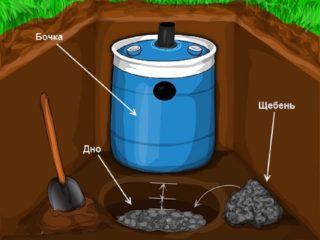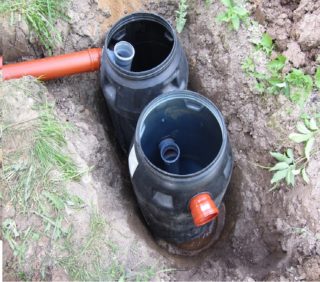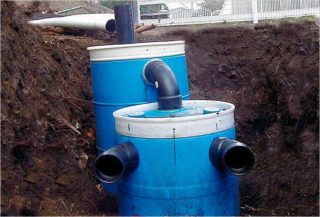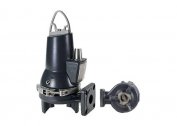Currently, not a single dwelling can do without a sewage system. And if apartment buildings are fully equipped with a wastewater intake system, then in the private sector this problem must be solved independently. Tighter construction standards and regulations, as well as environmental requirements in this direction, makes it necessary to improve the design of septic tanks. The use of leaking cesspools becomes unacceptable, only in the case of sewage less than 1 cubic meter per day. The availability of hot water, dishwashers and washing machines, together with the benefits provided, increases the value of drains.
The use of sealed or non-septic filtration systems is a direct threat to the fertility of the land. In addition to the possibility of plant infection, there is the likelihood of infectious diseases in pets and guests at home. In this case, you can not do without a fully functional sealed septic tank. The construction of such a structure will be considered in this article. We will analyze the possibility of using certain containers, of various volumes and methods of their installation.
Principle of operation
 The sewage collection design consists of piping systems (both in the house and on the street), a tank buried in the ground and connected to a pipe system. The whole structure can be either airtight or open.
The sewage collection design consists of piping systems (both in the house and on the street), a tank buried in the ground and connected to a pipe system. The whole structure can be either airtight or open.
Waste water flows through a piping system by gravity into a tank. As the tank is filled, water is pumped out using a sewage machine. The tank for collecting waste water can be made of any material: concrete, metal or plastic. The main requirement of each of them is tightness.
Advantages and disadvantages
 Each of the listed materials for the manufacture of a septic tank has its own strengths and weaknesses. Consider the criteria for each of them.
Each of the listed materials for the manufacture of a septic tank has its own strengths and weaknesses. Consider the criteria for each of them.
The advantage of each septic tank, as already mentioned, is environmental safety. Concrete septic tanks, in addition, have a large volume, therefore, the filling process will take longer and less often will have to order a cesspool machine. Metal containers, like concrete, have good rigidity, which will facilitate the filling process during installation. Plastic tanks, in turn, have a high degree of resistance to the aggressive environment of wastewater. This circumstance determines their long period of service. Also, the ease of construction allows you to independently mount it.
The disadvantage of the designs will be the following points. Concrete tanks are difficult to manufacture and have a high cost, metal are highly susceptible to corrosion. Depending on the volume, steel tanks can also require great efforts, costs and the involvement of special equipment. Plastic containers, due to their small dimensions, have small volumes and require frequent involvement of a sewage machine. In addition, additional thermal insulation or deepening will be required to protect against the effects of low temperatures.
Installation of a plastic container
 Before starting construction, it is necessary to determine the location of the septic tank. In this case, the following requirements for the minimum permissible distances to capital construction facilities should be taken into account. When measuring the distance to the apartment building from the edge of the septic tank, it should not be less than 5 meters, both to your own and to the neighbor's. The size of the distance to the edge of the adjacent section (fence) should not be less than 2 meters. Also, there should be an option for accessing the cesspool machine to the tank.
Before starting construction, it is necessary to determine the location of the septic tank. In this case, the following requirements for the minimum permissible distances to capital construction facilities should be taken into account. When measuring the distance to the apartment building from the edge of the septic tank, it should not be less than 5 meters, both to your own and to the neighbor's. The size of the distance to the edge of the adjacent section (fence) should not be less than 2 meters. Also, there should be an option for accessing the cesspool machine to the tank.
The container should be installed in a prepared pit with a depth greater than the height of the tank, but not less than 40 cm. The bottom of the pit should be poured, moistened with water and rammed with a sand mixture. In the case of heaving of the soil will have to prepare a concrete base. The width of the pit should exceed the dimensions of the tank by 10-20 cm. Next, the tank is installed and docked with communications.
Filling the container should be done with great care, since the walls of the vessel are made of soft material and are subject to deformation. Backfill is made with a sand mixture in small quantities. As you add, tamping is done. To ensure that the walls of the barrel are not damaged during backfilling, it is advisable to fill the container with water. Complete backfill when reaching the top of the tank.
The next step will be to connect the tank with the piping system and install the ventilation shaft.
As already mentioned, to prevent freezing of water in the tank, it is necessary to perform thermal insulation. To do this, install the frame above the tank and lay the heat-insulating plates. Plates are preferably used from a moisture-resistant material, the layer height is 10-15 cm. We sprinkle the entire structure with sand and a layer of soil. The ventilation pipe must extend above ground level and have a visor. The hatch for cleaning the tank is flush with the bulk soil. In order to avoid collision and damage to the design of the septic tank, it is advisable to mark the area with the installation of the tank against the background of general improvement.


